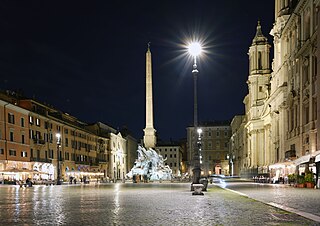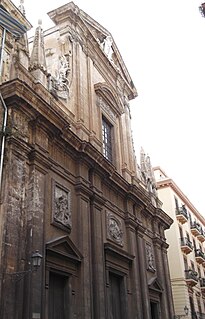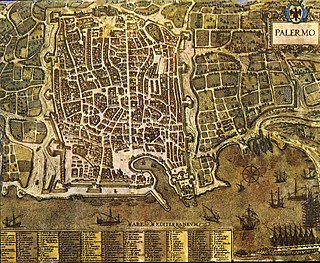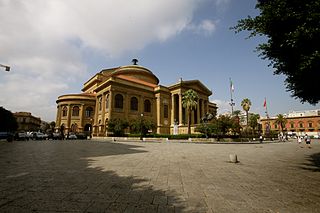
Palermo is a city in southern Italy, the capital of both the autonomous region of Sicily and the Metropolitan City of Palermo, the city's surrounding metropolitan province. The city is noted for its history, culture, architecture and gastronomy, playing an important role throughout much of its existence; it is over 2,700 years old. Palermo is in the northwest of the island of Sicily, by the Gulf of Palermo in the Tyrrhenian Sea.

Piazza Navona is a public open space in Rome, Italy. It is built on the site of the Stadium of Domitian, built in the 1st century AD, and follows the form of the open space of the stadium. The ancient Romans went there to watch the agones ("games"), and hence it was known as "Circus Agonalis". It is believed that over time the name changed to in avone to navone and eventually to navona.

The Teatro Massimo Vittorio Emanuele is an opera house and opera company located on the Piazza Verdi in Palermo, Sicily. It was dedicated to King Victor Emanuel II. It is the biggest in Italy, and one of the largest of Europe, renowned for its perfect acoustics.

Castro Pretorio is the 18th rione of Rome (Italy), identified by the initials R. XVIII, and it is located within the Municipio I. The rione takes its name by the ruins of the Castrum Praetorium, the barracks of the Praetorian Guard, included in the Aurelian Walls.

The Via del Corso is a main street in the historical centre of Rome. It is straight in an area otherwise characterized by narrow meandering alleys and small piazzas. Considered a wide street in ancient times, the Corso is approximately 10 metres wide, and it only has room for two lanes of traffic and two narrow sidewalks. The northern portion of the street is a pedestrian area. The length of the street is roughly 1.5 kilometres.
Quattro Canti, officially known as Piazza Vigliena, is a Baroque square in Palermo, region of Sicily, Italy. The site is the intersection of two major streets in Palermo, the Via Maqueda and the Corso Vittorio Emanuele. On the southwest corner stands the church of San Giuseppe dei Padre Teatini. A few steps away along the flank of this church, behind the Southeast corner building, along Via Maqueda is the Piazza and Fontana Pretoria, sandwiched between this church and Santa Caterina. A few more steps reaches San Cataldo and the church of La Martorana.

Piazza Pretoria, also known as square of Shame, is at the limits of the district of Kalsa, near the corner of Cassaro with Via Maqueda, just a few meters from the Quattro Canti, the exact center of the historic city of Palermo.
Laura Giordano is an Italian lyric soprano.

The Church of Saint Nympha is a Baroque-Mannerist church of Palermo. The facade rises on Via Maqueda, a block north of the central intersection known as the Quattro Canti, in the quarter of Seralcadi, within the historic centre of Palermo. The church belongs to the Camillians.

The Praetorian Fountain is a monumental fountain located in Piazza Pretoria in the historic center of Palermo, region of Sicily, Italy. The fountain dominates the piazza on the west flank of the church of Santa Caterina, and is one block south of the intersection of the Quattro Canti. The fountain was originally built in 1544 in Florence by Francesco Camilliani, but was sold, transferred, and reassembled in Palermo in 1574.

Porta Felice is a monumental city gate of Palermo, Sicily; the gate is located in the zone of the Foro Italico and the Castellamare quarter. It represents the water-side entrance into what was formerly known as Via Cassaro, the most ancient main street of the city, but renamed Via Vittorio Emanuele after Italian unification. The gate was built in Renaissance and Baroque styles between the 16th and 17th centuries.

Porta Nuova is a monumental city gate of Palermo. It represents the entrance of the Cassaro from Corso Calatafimi and is located beside Palazzo dei Normanni, royal palace of Palermo. The gate was built to celebrate Charles V's conquest of Tunis (1535) and his visit to the capital of the Kingdom of Sicily.

The Cassaro is the most ancient street of Palermo. From the late 16th century the street also had the name Via Toledo. Following the unification of Italy, it was officially renamed Via Vittorio Emanuele II, but the old and distinctive name is still in use. The street is rooted in the age of the foundation of Palermo by the Phoenicians. It provides access to a number of important sights, including the Royal Palace and the Cathedral, two UNESCO World Heritage Sites.

The Church of Saint Matthew is a Baroque-style, Roman Catholic church of Palermo, region of Sicily, Italy. It is located in the main street of the city, the ancient Cassaro now Corso Vittorio Emanuele, in the quarter of the Loggia, about a block east of the Quattro Canti, within the historic centre of Palermo.

Piazza Verdi, commonly known as Piazza Massimo, is a square of Palermo. At its centre is the sumptuous Teatro Massimo, the biggest opera house of Italy, and the third of Europe after the Opéra National de Paris and the K. K. Hof-Opernhaus in Vienna. The square is located in the heart of the city, near the central Via Maqueda, in the quarter of the Seralcadio, within the historic centre of Palermo.

Mariano Smiriglio was a Sicilian architect, painter and decorator, known as a protagonist of the Mannerist-Baroque era in Palermo.

The following outline is provided as an overview of and topical guide to Palermo:

San Nicola da Tolentino, or more in non-dialect known as the church Saint Niccolò da Tolentino, is a Roman Catholic church located on via Maqueda #157, between via dei Calderai and via Giardinaccio, at the Southwest border of the quarter of Kalsa (Tribunali) of the historic centre of Palermo, region of Sicily, Italy.




















